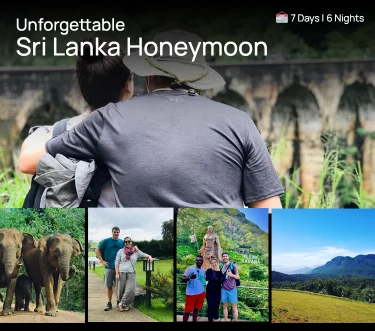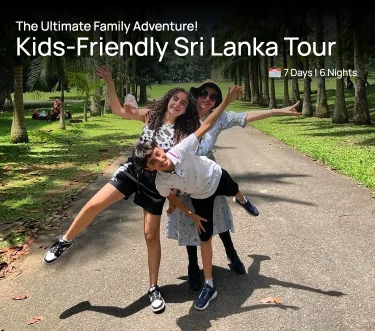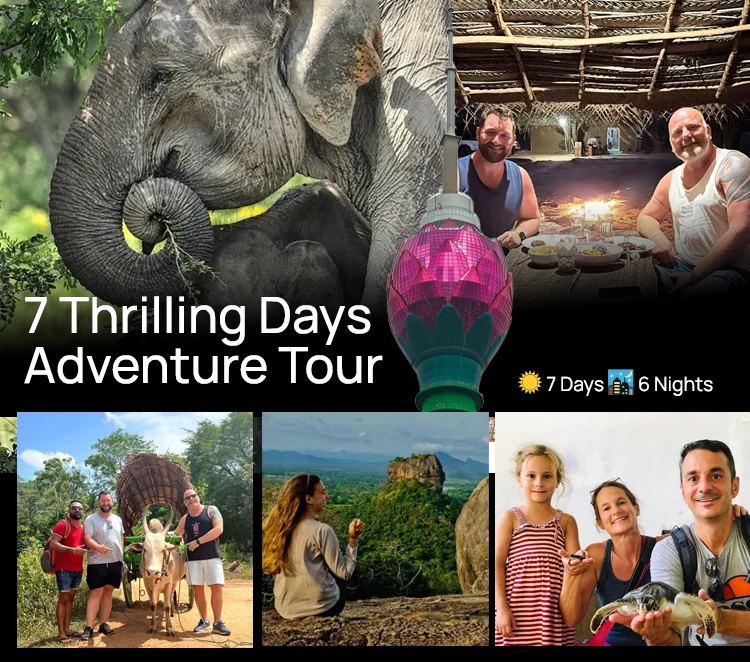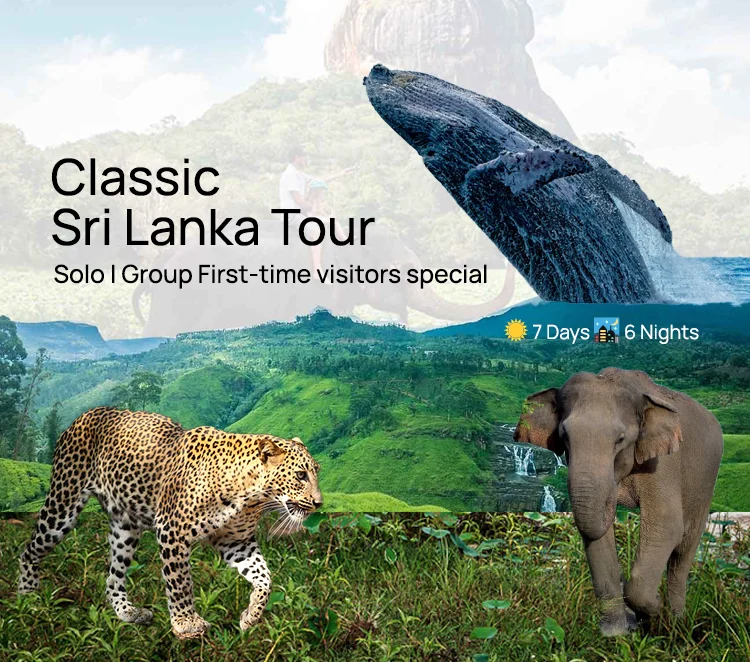6 Breathtaking Waterfalls
Natural Wonders of Sri Lanka You Can’t Miss
If you’ve ever dreamed of being surrounded by misty mountains, lush rainforests, and the sound of cascading water echoing through the valley — Sri Lanka is calling your name. Tucked away in its hill country and highland forests are some of the most awe-inspiring waterfalls in the world, each offering a unique blend of adventure, serenity, and cultural richness.
Whether you’re planning your next tropical escape or just dreaming with your coffee, here’s a look at 6 unforgettable waterfalls in Sri Lanka, and why global travellers fall in love with each one.
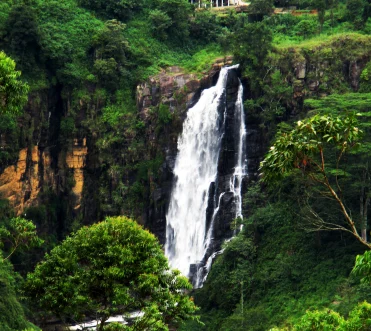
1. Devon Falls – The Veil of the Valley
📍 Nuwara Eliya District | ⛰️ 97m tall
Tucked into the lush hills of Talawakele, just outside Nuwara Eliya, lies one of Sri Lanka’s most graceful natural wonders — Devon Falls. Often referred to as “The Veil of the Valley,” this stunning waterfall gently cascades down a rocky face surrounded by emerald green tea plantations and misty hill slopes.
Why It’s Called “The Veil of the Valley”
The nickname comes from the waterfall’s delicate, almost bridal-veil-like flow. At 97 metres high, the water fans out in a smooth, white stream, contrasting dramatically against the dark rocks and deep green vegetation. It’s a soft, romantic cascade that creates an ethereal scene — especially when the morning sun casts a glow over the valley or fog rolls in, cloaking everything in mystery.
📍 Where is Devon Falls?
Devon Falls is located on the A7 highway, which connects Hatton to Nuwara Eliya. It’s just a brief stop from Talawakele town, and what makes it even more appealing to travellers is that it’s visible right from the roadside — no long hike needed!
✨ Why Tourists Love Devon Falls
- ✅ Easily accessible with stunning roadside viewpoints
- ✅ Perfect for photography — especially with the nearby tea fields as a backdrop
- ✅ A great stopover on the way to other attractions like St. Clair’s Falls and Nuwara Eliya
- ✅ Ideal for couples or solo travellers looking for serenity and scenery
For travellers who want to experience Sri Lanka’s hill country without strenuous trekking, Devon Falls is a dream spot — dramatic in appearance, yet gentle in spirit.
📸 Best Time to Visit
The waterfall is at its most photogenic during the monsoon months (April to September) when water levels are high. Visit in the early morning or late afternoon for soft, diffused lighting and fewer crowds.
🧭 Insider Tip
Head to the viewing platform across from the Mlesna Tea Centre for the best panoramic shot of the falls. Grab a cup of Ceylon tea while soaking in the view — a true Sri Lankan moment.
2, 🌿 St. Clair’s Falls – “Little Niagara of Sri Lanka”
📍 Nuwara Eliya District | ⛰️ 80m tall, wide twin falls
Nestled in the emerald highlands of Talawakele, just minutes from Devon Falls, lies the wide, frothy beauty of St. Clair’s Falls — affectionately known as the “Little Niagara of Sri Lanka.” With its broad flow, lush surroundings, and tea-scented breeze, this waterfall is not just a scenic stop — it’s an experience that captures the essence of
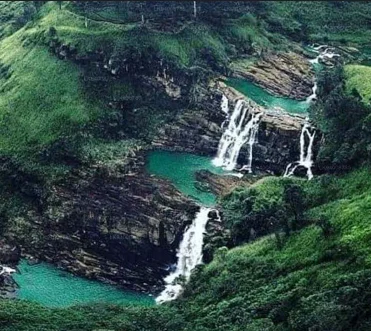
Sri Lanka’s hill country charm.
🏞️ What Makes St. Clair’s Falls So Special?
At approximately 80 metres high and 50 metres wide, St. Clair’s isn’t the tallest in the country — but it’s among the most picturesque and accessible. Its twin cascades tumble gracefully down a rocky slope into a valley blanketed with tea plantations, creating a scene straight out of a postcard.
This wide, curtain-like flow has earned it the nickname “Little Niagara,” not because of sheer power, but due to its dramatic, panoramic width that spreads across the landscape.
📍 Where Is It Located?
St. Clair’s Falls is located along the Hatton–Talawakele road (A7), about 3 km west of Talawakele town in the Nuwara Eliya District. It’s easily seen from the road, making it a convenient and rewarding photo stop on your way to Nuwara Eliya or Horton Plains.
✨ Why Tourists Love St. Clair’s Falls
- ✅ Accessible with minimal walking – perfect for families, seniors, or casual explorers
- ✅ Surrounded by picturesque tea estates – ideal for photography and drone footage
- ✅ One of the widest waterfalls in Sri Lanka
- ✅ Often paired with Devon Falls for a two-in-one waterfall excursion
- ✅ Great spot for a quick picnic or tea break overlooking the valley
🧭 When to Visit
St. Clair’s is best viewed during and just after the monsoon season (April–October), when water levels are high and the falls are at their most dramatic. Early morning and late afternoon provide the best lighting for photos, while mist adds an atmospheric touch.
📸 Pro Travel Tip
Head to the Mackwoods Tea Centre or St. Clair’s Tea Castle for a cup of Ceylon tea and an unbeatable view. Some of the best panoramic shots are captured from these viewpoints, where you can see both the falls and the vast plantation landscape in one frame.
3. 🏞️ Baker’s Falls – The Hidden Gem of Horton Plains
Tucked away in the misty cloud forests of Horton Plains National Park, Baker’s Falls is one of Sri Lanka’s most enchanting and lesser-known waterfalls. While it may not be the tallest or loudest, its secluded setting, lush surroundings, and magical atmosphere make it a favourite among nature lovers and trekkers who venture off the beaten path.
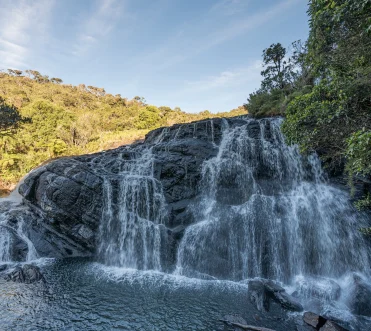
🌿 Why It’s Called a “Hidden Gem”
Unlike roadside waterfalls like Devon or Ravana, Baker’s Falls requires a bit of effort to reach — but that’s part of its appeal. Found deep within Horton Plains, the fall reveals itself midway through the park’s iconic 9 km nature loop, after winding through cloud forest, open grasslands, and alpine meadows.
When the silence of the forest gives way to the sound of water crashing onto rocks, you know you’re close to discovering this gem.
📍 Where is Baker’s Falls?
Located inside Horton Plains National Park (a UNESCO World Heritage Site) in the Nuwara Eliya District, Baker’s Falls sits at an elevation of over 2,100 metres. Visitors must trek roughly 3 km from the park entrance along a scenic, moderately challenging trail — the same one leading to World’s End, a dramatic cliff drop popular among hikers.
✨ Why Tourists Love Baker’s Falls
- ✅ Unique setting inside a pristine highland forest
- ✅ Cool climate and peaceful atmosphere, perfect for nature lovers
- ✅ Surrounded by rhododendron trees and rare plant species
- ✅ Less crowded than more accessible waterfalls
- ✅ Offers a true wilderness experience — ideal for trekking and eco-tourism
📸 What Makes It Picture-Perfect?
Baker’s Falls plunges about 20 metres over a dark rocky ledge, cascading into a clear pool below. The mist rising from the impact, combined with the thick vegetation and moss-covered rocks, creates a mysterious, untouched look that feels worlds away from modern life.
Photographers love the moody lighting and misty ambiance, especially in the early morning when the light filters through the forest canopy.
🧭 Best Time to Visit
Visit early morning (before 9:00 AM) for fewer crowds and better visibility. The best months are January to April, when the skies are clearer and the trail is dry and safe. Avoid during peak monsoon months when paths can become slippery.
🌍 A Tribute to Exploration
The falls are named after Sir Samuel Baker, a 19th-century British explorer who helped map the central highlands of Sri Lanka. His legacy lives on through this waterfall that continues to inspire the spirit of exploration in every traveller who sees it.
You can book your tour with Lanka Tour Driver to enjoy the venu, Check our Packages
4. 🏔️ Bambarakanda Falls – The Tallest Waterfall in Sri Lanka
If you’re searching for Sri Lanka’s most jaw-dropping natural landmarks, Bambarakanda Falls deserves a place right at the top — literally. At a staggering 263 metres (863 feet) in height, it proudly holds the title of the tallest waterfall in Sri Lanka, offering a dramatic vertical drop that’s as awe-inspiring as it is humbling.
🌿 Where Nature Stands Tall
Hidden in the Badulla District, near the small village of Kalupahana, Bambarakanda Falls is nestled deep within a
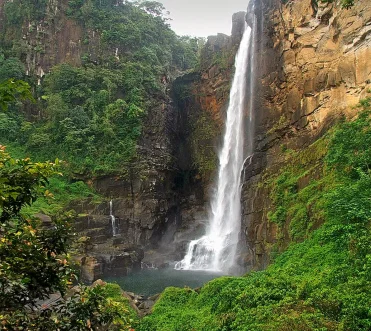
pine forest in a region untouched by the chaos of modern life. It’s not just a waterfall — it’s a journey into the wild side of Sri Lanka.
To reach it, you’ll take a scenic drive through winding hill roads and walk a short forest trail. As the sound of rushing water grows louder and trees begin to thin, the towering falls come into view — cascading down a near-vertical rock face into a tranquil pool below. It’s a truly raw and powerful scene, perfect for nature purists and adventure seekers alike.
📍 Where Is Bambarakanda Falls?
Located in Kalupahana, between Belihuloya and Haputale, Bambarakanda is about:
- 🛻 5 hours from Colombo
- 🚙 2 hours from Nuwara Eliya
- 🚶♂️ Just a 15–20 minute walk from the nearest vehicle access point
Though slightly off the usual tourist track, its seclusion is part of the charm.
✨ Why Tourists Love Bambarakanda Falls
- ✅ Tallest waterfall in the country – a bucket-list destination for waterfall lovers
- ✅ Moderate hiking route through pine forests and scenic landscapes
- ✅ Ideal for wildlife spotting, including birds and mountain lizards
- ✅ Perfect for drone photography and wide-angle landscape shots
- ✅ Quiet and less crowded than mainstream tourist spots
📸 Pro Tip: Don’t Just Snap from Afar
You can trek to the base of the falls, where the spray cools the air and the sound is thunderous. For the truly adventurous, there’s a hiking route to the top, offering surreal bird’s-eye views — but only attempt this with a local guide due to slippery paths and steep terrain.
🧭 Best Time to Visit
The best viewing season for Bambarakanda Falls is between April and September, right after the monsoon rains, when the waterfall is full and flowing powerfully. The surrounding pine forests are also at their greenest during this period.
Avoid December–February if possible, as mist and rain can obstruct views and make the trail slippery.
🌍 A Must-Visit on Sri Lanka’s Waterfall Trail
Bambarakanda isn’t just the tallest — it’s one of the most underrated natural gems in Sri Lanka. With fewer tourists and unspoiled surroundings, it offers authentic peace and immersion in nature, making it a favourite among eco-tourists and photography enthusiasts.
5. 🌫️ Dunhinda Falls – The Smoky Wonder of Badulla
If you’re looking for a waterfall that blends natural beauty with a sense of mystery, look no further than Dunhinda Falls — often hailed as one of the most beautiful waterfalls in Sri Lanka. Nestled just outside Badulla, this stunning 64-metre cascade is known for its thick misty spray that gives it a dreamlike, almost magical feel. It’s no wonder locals lovingly call it the “Smoky Fall” (‘Dun’ meaning mist or smoke in Sinhala).
🌿 Why Dunhinda Is a Must-See
What sets Dunhinda apart is not just its visual appeal, but the journey to get there. Unlike more easily accessible
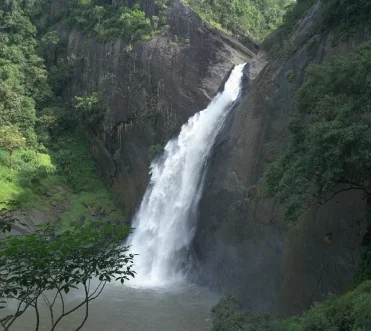
falls, Dunhinda requires a scenic 1.5 km jungle trek through lush forest trails — making the experience feel more like an adventure than a simple tourist stop. As you walk, birds chirp overhead, butterflies flutter along your path, and the distant roar of the waterfall grows louder with each step.
When you finally reach the viewing platform, you’re rewarded with a powerful vertical drop that plunges into a rock basin, sending up thick plumes of white mist that dance in the sunlight. It’s wild, untamed, and unforgettable.
📍 Where Is Dunhinda Falls?
Dunhinda Falls is located about 5 km from Badulla town in Sri Lanka’s Uva Province. It’s easily reachable via a short tuk-tuk or car ride, followed by a 20–30 minute walk through marked forest trails.
✨ Why Tourists Love Dunhinda Falls
- ✅ Known for its powerful mist and dramatic scenery
- ✅ Offers a nature-filled forest trek that’s accessible but adventurous
- ✅ Great for wildlife and birdwatching
- ✅ Ideal for photographers and nature lovers
- ✅ Less commercialized, offering a more authentic local experience
📸 Best Time to Visit
The ideal time to visit Dunhinda Falls is between May and September, just after the early monsoon rains. During this period, the water flow is strong, and the surrounding forest is lush and vibrant. Avoid during heavy monsoons, as the path can get slippery and muddy.
🧭 Insider Tip
Wear comfortable hiking shoes and bring insect repellent. The trail is mostly flat but can be muddy after rain. Early mornings or late afternoons offer the best light for photos, and you’ll likely have more solitude.
🌍 More Than Just a Waterfall
What makes Dunhinda truly special is its raw energy and untouched surroundings. Unlike other waterfalls that can feel more curated or crowded, Dunhinda retains a wild, almost spiritual atmosphere — a reminder of nature’s power and beauty.
You might also hear local legends about the origins of the falls and its name, adding a touch of folklore to your adventure.
6. 🏔️ Ravana Falls – Where Myth Meets Nature
Few places in Sri Lanka blend natural beauty with ancient legend as seamlessly as Ravana Falls. Located near the picturesque town of Ella in the Uva Province, this majestic waterfall is one of the most accessible and iconic in the country. But beyond its striking appearance lies a story that reaches deep into Sri Lanka’s mythological past — making it a must-visit for nature lovers and culture seekers alike.
🌊 A Waterfall Steeped in Legend
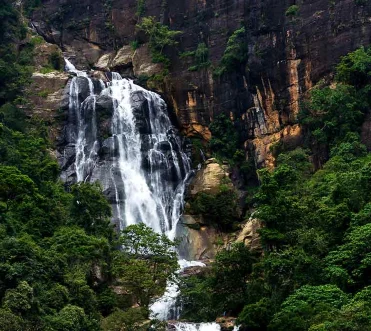
Standing at about 25 metres in height, Ravana Falls may not be the tallest, but it’s undoubtedly among the most
symbolic. According to the great Indian epic Ramayana, this is where King Ravana — the ancient ruler of Lanka — is said to have hidden Princess Sita in a nearby cave after abducting her. The very cave, known today as Ravana Cave, still exists above the falls and can be visited by those willing to climb a steep stair trail.
This mythical connection draws travellers from across the world, especially those intrigued by cultural tourism and sacred legends.
📍 Where is Ravana Falls?
Ravana Falls is located just 6 km from Ella town, right beside the Ella–Wellawaya main road. Its roadside position makes it one of the most photographed and visited waterfalls in Sri Lanka — perfect for a quick stop or as part of a full-day Ella adventure.
✨ Why Tourists Love Ravana Falls
- ✅ Easily accessible – no hiking required
- ✅ Tied to the legend of King Ravana and the Ramayana
- ✅ Perfect photo stop on the way to Ella Gap, Little Adam’s Peak, or Nine Arches Bridge
- ✅ Small natural pools form at the base — great for dipping your feet
- ✅ Surrounded by lush jungle and dramatic cliffs
📸 Best Time to Visit
Ravana Falls is most spectacular during the rainy season (May to September), when water cascades in multiple tiers over rugged rocks. During drier months, the flow reduces but still offers a picturesque sight. For softer lighting and fewer crowds, plan your visit during early morning or late afternoon.
🧭 Insider Tips
- 🚶♂️ For those craving more adventure, hike up to Ravana Cave for a deeper dive into the legend. The trail is steep but rewarding.
- 📸 Stand across the road or climb up the rocks slightly to get the best wide-angle photo of the falls.
- ⚠️ Avoid swimming during heavy rains due to strong currents and slippery rocks.
🌍 Where Myth Meets Natural Majesty
What makes Ravana Falls so unforgettable isn’t just its roaring white waters, but the timeless story it carries. Whether you’re a history buff, a solo adventurer, or a couple on a romantic escape, this waterfall offers a unique blend of culture, accessibility, and scenic charm.
Frequently Asked Questions
What is the best time to visit waterfalls in Sri Lanka for a scenic experience?
The ideal months are May to October, especially after early monsoon showers, when waterfalls are at full force without extreme weather disruptions.
Are Sri Lanka waterfall tours suitable for seniors or kids?
Yes! Most sites like St. Clair’s, Devon, and Ravana Falls have easy access, while more remote ones like Dunhinda or Bambarakanda may require moderate walking.
What should I pack for a Sri Lankan waterfall and nature tour?
Bring light trekking shoes, rain protection, insect repellent, a reusable water bottle, and layers for chilly mornings in the hill country.
Can I swim in the waterfalls listed in this Sri Lanka tour?
Swimming is allowed in designated areas near Ravana Falls and some natural pools. Always check safety signs or ask the guide before entering water.
Why is this Sri Lanka waterfall tour considered one of the most breathtaking experiences?
Because it combines iconic waterfalls, hidden gems, lush forests, and cultural touchpoints in a single, well-paced itinerary that fits both thrill-seekers and relaxation lovers.
By following these guidelines, you’ll not only show respect for Sri Lanka’s sacred places but also enrich your own experience of these timeless spiritual treasures. Enjoy your journey through Sri Lanka’s hallowed halls of worship – it’s sure to be as enlightening as it is unforgettable!
